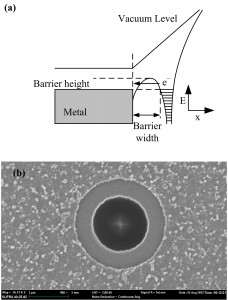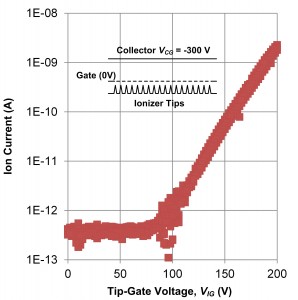Self-aligned Gated Tip Arrays for Low-voltage, High-pressure Field Ionization of Gases
- Category: Energy, Nanotechnology
- Tags: arash fomani, luis velasquez-garcia
Field ion sources operate based on field ionization (FI) phenomena in which an electron tunnels out of a molecule under the influence of a high electric field that lowers and narrows the potential barrier (see Figure 1a). Excellent characteristics in terms of low power consumption, soft-ionization capability, and possibility to operate at high pressures render these devices very attractive for portable analytical instruments. Most commonly, field ionizers are used in field ion mass spectrometers[1] and gas chromatography field ion mass spectrometry systems[2] for analysis of organic molecules and petroleum products. Field ionizers are also investigated for application in atom beam microscopes for study of surface physics[3] and neutron generators for oil-well logging[4]. Although promising, application of field ionizers for portable equipment is currently limited by high operating voltages as the state-of-the-art devices require voltages in excess of 500 V to generate ion currents in nA-range needed for most practical applications[5][6][7].
We designed and fabricated massive arrays of resilient, self-aligned gated nanoscale tips that are capable of field ionizing gases at voltages as low as 150 V. Photolithography and oxidation sharpening were employed to produce a self-aligned device configuration and highly uniform gate and tip dimensions. Electric fields higher than 20 V/nm can be generated with tip-to-gate biases below 200 V that are sufficient to field ionize even helium, with the highest ionization potential of any molecule. The proposed gated tips (Figure 1b) have average tip radii < 5 nm and gate apertures of 3 µm. We demonstrated field ionization of nitrogen at pressures as high as 10 Torr with onset fields of 8–10 V/nm and ion currents > 1 nA at 200 V tip-to-gate bias, as shown in Figure 2.
- Figure 1: (a) Potential-energy diagram during the field ionization process and (b) SEM image of a self-aligned gated tip.
- Figure 2: Field ionization of N2: ion current vs. tip-to-gate voltage, VIG, at 10 Torr. Inset shows the experimental setup.
- H. D. Beckey, Principles of Field Ionization and Field Desorption Mass Spectrometry, New York: Pergamon Press, London, 1977. [↩]
- K. Qian, G. J. Dechert, and K. E. Edwards, “Deducing molecular compositions of petroleum products using GC-field ionization high resolution time of flight mass spectrometry,” Int. J. Mass. Spectrom., vol. 265, no. 2–3, pp. 230-236, Sept. 2007. [↩]
- D. J. Riley, M. Mann, D. A. MacLaren, P. C. Dastoor, W. Allison, K. B. K. Teo, G. A. J. Amaratunga, and W. Milne, “Helium detection via field ionization from carbon nanotubes,” Nano Lett., vol. 3, pp. 1455−1458, 2003. [↩]
- A. Persaud, I. Allen, M. R. Dickinson, T. Schenkel, R. Kapadia, K. Takei, and A. Javey, “Development of a compact neutron source based on field ionization processes,” J. Vac. Sci. Tech. B, vol. 29, no. 2, pp. 02B107-1−4, Mar 2011. [↩]
- C. A. Spindt, “Microfabricated field-emission and field-ionization sources,” Surface Science, vol. 266, no. 1, pp. 145-154, Apr. 1992. [↩]
- L.-Y. Chen, L. F. Velásquez-García, X. Wang, K. Teo, and A. I. Akinwande, “A micro ionizer for portable mass spectrometers using double-gated isolated vertically aligned carbon nanofiber arrays,” in IEDM Tech. Dig., pp. 843−846, 2007. [↩]
- B. Bargsten Johnson, P. R. Schwoebel, C. E. Holland, P. J. Resnick, K. L. Hertz, and D. L. Chichester, “Field ion source development for neutron generators,” Nucl. Instrum. Meth. A, vol. 663, pp. 64−67, 2012 [↩]

